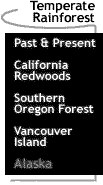Temperate Rainforest: Alaska
The Rain Forests of Alaska
The forests of southeast Alaska are different from most forests in the
contiguous United States in several important ways. First, they are cooler and wetter.
Many areas are covered with standing water and soggy muskegs. About 4 million Tongass
acres consist of wetlands, some of which are sparsely forested by slow-growing trees and
shrubs.
Second, the Tongass is a naturally fragmented forest. It exists along a thin strip of
coastline divided by glaciated river valleys and bordered by steep ice fields. The
Alexander Archipelago, which encompasses hundreds of islands of varying sizes, fragments
the forest even further. Highly productive (high-volume) forestlands comprise only 4
percent of the Tongass land base.
Third, large-scale fires never burned on the Tongass. Natural gaps in the forest occur
in southeast Alaska when heavy winds topple shallow-rooted trees. Natural gaps the size of
a 100-acre clearcut are rare.
The unique geography and unusually wet climate of the Tongass have given rise to a
complex and diverse mix of habitat types - ocean, ice, forests, scrubland, and wetlands.
The high level of natural fragmentation found on the Tongass must be taken into account in
developing a scientifically sound management strategy. Association
of Forest Service Employees for Environmental Ethics. 1996. Tongass in transition:
Blueprint for a Sustainable Future; the AFSEEE - Sponsored Alternative Plan for the
Tongass National Forest in southeast Alaska. 102 pages.
A map of
southeast Alaska
A map of
the old growth on a section of the Tongass National Forest, s.e. Alaska.
The Alaskan Temperate Rainforest
Southeast Alaska and rainforests to the south [of Juneau] share a maritime
climate and many of the same rainforest plant and animal species. These northern forests
also differ in several ways. The big trees of southeastern Alaska and northern Bristish
Columbia are topographically more restricted than the (prelogged!) lowland old growth
forests of Washington and Oregon. And at southeastern Alaskan latitudes, the big timber is
also restricted to low elevations. © 1996. Carstensen, R. Southeast
Alaska. In R. Kirk (Ed.), The Enduring Forests. Seattle: The Mountaineers, p. 151.
Trees of the Alaskan Coastal Rainforest
Another distinction is that here in the north we have fewer tree species
than in the rest of the coastal forest. Pacific yew and Pacific silver fir barely make it
into southern southeast Alaska. Western Redcedar reaches Petersburg, perhaps limited to
that latitude and southward by the growing-season temperatures and winter snow damage to
leaders. Shore pine (Pinus contorta) grows in peatland as far north as Yakutat. Western
hemlock and yellow-cedar extend beyond Southeast Alaska to Prince William Sound. Sitka
spruce is more confined than other rainforest trees to the narrow coastal belt, yet it
persists farther northward than any of the others; it thrives as far as Cook Inlet, where
it hybridizes with the white spruce of the vast boreal interior. ©
1996. Carstensen, R. Southeast Alaska. In R. Kirk (Ed.), The Enduring Forests.
Seattle: The Mountaineers, p. 153.
Coastal Alaskan Shoreline
Southeastern Alaska has 15,500 miles of convoluted shoreline. © 1996. Carstensen, R. Southeast Alaska. In R. Kirk (Ed.), The
Enduring Forests. Seattle: The Mountaineers, p. 150.
Alaska Rainforest Links
You may want to explore the following Web sites for more
information about the Tongass National Forest, southeastern Alaska's rainforest.
A description
of the Tongass National Forest.
Alaska Rainforest
Campaign, a coalition of environmetal organizations working to perserve the temperate
rainforest, including the Tongass National Forest.
Southeast Alaska Council has
a list of "myths" about
logging and conservation.
A U.S. News and World Report article entitled "At War in an Ancient
Forest".
[ Percent Landmass Coverage ]
[ Temperate Rainforest: Past & Present / California Redwoods /
S. Oregon Forest / Vancouver Is. / Alaska ]
[ Environmental Influences ]
[ Glossary
] [ Related Links
]
[ References
] [ PBL Model
]
[ Home
] [ Teacher
Pages ] [ Modules
& Activities ]
|



